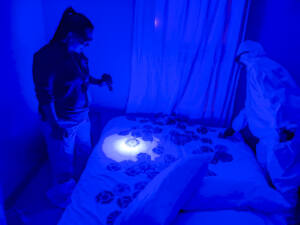Semen Analysis

In semen analysis, an alternative lights source like a laser is used to find stains on bed sheets or clothing. Once a stain is found it is sent to be tested to determine the type of biological fluid it is. If the biological fluid is not blood the other options are saliva, urine or semen. DNA profiling starts from the identification of a stain as seminal fluid. Once this is determined it is important for the DNA analyst to determine if sperm is present in the fluid. It’s important to determine if sperm is present because it contains a great deal of DNA, which could help to identify a suspect. Once it has been determined that sperm is present, the analyst must determine which item of evidence or swab sample has the most sperm so that getting a DNA profile is more likely.
Sperm is identified by using a combination of general cell staining and bright field microscopy. This has been around for forty years. This is the most popular method to detect sperm but it is not the best method because it takes hours for an analyst to search for sperm. However, it is more common because sperm that has been isolated from a sexual assault has lost most if not all of the sub-cells that are needed for morphological identification. There is a method that has been developed called SPERM HY-LITER™. This method is a fluorescent monoclonal antibody-based kit which is used for microscopic identification. “Forensic Detection of Sperm from Sexual Assault Evidence” describes the kit as follows:
SPERM HY-LITER™ is designed to provide positive identification of sperm using a unique monoclonal antibody that has been chemically tagged with an Alexa 488 fluorophore. The kit incorporates a second fluorescent dye, 4′,6-diamidino-2-phenylindole (DAPI) that will stain all cell nuclei; this is a fluorescent analogue of the KPIC stain currently used in most DNA forensic laboratories. By combining both fluorescent dyes, SPERM HY-LITER™ provides several visually confirmatory steps for the identification of sperm. Sperm can be visualized in the fluorescein channel (the fluorescent spectra of Alexa 488 falls conveniently within the emission maximum for fluorescein); all cell nuclei can be seen in the DAPI channel; and using specialized dual filter ‘cubes,’ epithelial nuclei and sperm can be visualized simultaneously.
Although semen can easily be identified through testing, finding sperm may not always be possible. Forensicscience.ie explains that semen in men who have had a vasectomy does not contain sperm, so in cases like this further confirmatory tests must be done.
Back to Forensic Investigation
Back to Crime Library
|
|
|

